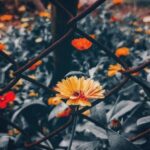Are you interested in creating a beautiful garden that not only adds color and life to your outdoor space, but also contributes to the well-being of our environment? If so, designing a butterfly garden may be the perfect project for you. In this article, we will delve into the fascinating world of butterfly gardens and explore their importance in sustaining the delicate balance of our ecosystem.
Butterfly gardens are specially designed areas that provide a hospitable environment for butterflies at various stages of their life cycle. These radiant creatures play an integral role in pollination and act as indicators of a healthy environment. By creating a butterfly garden, not only can you enjoy the vibrant beauty they bring, but also help ensure their survival.
The benefits of butterfly gardens extend far beyond their aesthetic appeal. These gardens provide critical habitats for multiple species of butterflies, which in turn serve as vital pollinators for plants and flowers. By nurturing these fluttering wonders, we are actively promoting biodiversity and conservation efforts. Join us as we embark on an exploration of how creating a butterfly garden can contribute to our environment’s health and well-being.
So grab your gardening tools and prepare to delve into the enchanting world of butterfly gardens. From choosing the right location to understanding essential elements and selecting butterfly-friendly plants, we will guide you through every step necessary to create a thriving haven for these delicate creatures. Let’s get started with discovering why butterfly gardens matter and how they can positively impact our surroundings.
Benefits of Butterfly Gardens
Butterfly gardens not only add beauty to your outdoor space, but they also play a crucial role in supporting the environment and ecosystem. Creating a butterfly garden can provide numerous benefits for both butterflies and other organisms in the surrounding area.
Conservation of Butterfly Species
One of the primary benefits of butterfly gardens is their contribution to the conservation of butterfly species. As natural habitats continue to be destroyed or disrupted by human activities, many butterfly species are facing decline in numbers. By creating butterfly gardens, you can provide a safe haven for these delicate creatures, helping to support their populations and prevent further decline.
Pollination of Plants
Butterflies are important pollinators, just like bees and other insects. When butterflies visit flowers in search of nectar, they inadvertently pick up pollen on their bodies and transfer it from one flower to another, aiding in fertilization and ensuring the reproduction of various plant species. This process is crucial for maintaining biodiversity and healthy ecosystems. By attracting butterflies to your garden, you are not only enhancing its beauty but also contributing to the pollination of plants.
Biodiversity Enhancement
Butterfly gardens promote biodiversity by attracting a wide range of butterfly species. Different species of butterflies have specific host plants that caterpillar larvae feed on before transforming into adult butterflies. By planting a variety of host plants in your garden, you create an environment that supports multiple stages of butterfly life cycles. This diversity helps to maintain balanced ecosystems by providing food sources for birds, other insects, and small mammals.
Choosing the Right Location
When creating a butterfly garden, one of the most crucial decisions you will need to make is choosing the right location. The location plays a significant role in determining the success and sustainability of your butterfly garden. There are several factors to consider when selecting the ideal spot for your butterfly garden.
First and foremost, it is important to choose a location that receives ample sunlight throughout the day. Butterflies are cold-blooded creatures, and they rely on sunlight to warm their bodies and energize themselves for activities like feeding and mating. Aim for a spot that gets at least six hours of direct sunlight daily.
Secondly, it is essential to select a location that provides some protection from strong winds. Butterflies are delicate creatures, and strong winds can easily damage their fragile wings. Choose an area surrounded by trees, shrubs, or fences that can act as windbreaks and provide shelter for butterflies.
Another factor to consider is the availability of nectar sources nearby. Nectar is the primary food source for adult butterflies, so having an abundant supply of nectar-rich flowers in close proximity is crucial. Ensure that there are flowering plants in the vicinity of your chosen location or be prepared to plant them yourself.
Additionally, avoid areas sprayed with pesticides or insecticides, as these chemicals can be harmful and toxic to butterflies. It’s best to choose a location away from agricultural fields or urban areas where pesticide use may be prevalent.
Lastly, consider accessibility when selecting your butterfly garden’s location. You will want a spot that is easily accessible for maintenance tasks such as weeding, pruning, and watering. It should also allow you to observe and enjoy the beauty of butterflies up close without disturbing their habitat.
By carefully considering these factors – sunlight exposure, wind protection, nearby nectar sources, pesticide-free environment, and accessibility – you can select the ideal spot for your butterfly garden that will support these majestic creatures while ensuring their survival and attracting more butterflies year after year.
Essential Elements of Butterfly Gardens
Butterflies are not only beautiful creatures but also important pollinators in our environment. Creating a butterfly garden can help support their population and contribute to the overall health of our ecosystem. To create an ideal habitat for butterflies, there are several essential elements that should be considered.
The first key component of a butterfly garden is the presence of host plants. These are plants that serve as food sources for butterfly larvae, or caterpillars. Different species of butterflies have specific host plant requirements, so it is important to research which plants are suitable for the butterflies native to your area.
For example, Monarch butterflies require milkweed plants as their exclusive host plant. By including these host plants in your garden, you provide a valuable food source and reproductive site for butterflies.
In addition to host plants, nectar-rich flowers are another essential element of a butterfly garden. Adult butterflies rely on flower nectar as their main source of nutrition. Planting a variety of flowering plants with different bloom times will provide a continuous supply of nectar throughout the season and attract a diverse range of butterfly species to your garden. Some popular nectar-rich flowers include lavender, coneflowers, zinnias, and bee balm.
Lastly, providing adequate shelter and water sources is crucial for creating an ideal habitat for butterflies. Butterflies need places to rest and seek shelter from extreme weather conditions such as strong winds or heavy rains. Planting dense shrubs or placing tall grasses in your garden can provide protective cover for butterflies. Additionally, incorporating water sources such as shallow dishes or birdbaths will enable butterflies to drink and stay hydrated.
Creating an ideal habitat for butterflies involves considering these essential elements: host plants for caterpillars, nectar-rich flowers for adults, and shelter and water sources. By incorporating these components into your butterfly garden layout design, you will attract a variety of butterfly species and support their populations while enjoying the beauty they bring to your outdoor space.
Selecting Butterfly-Friendly Plants
When designing a butterfly garden, one of the most crucial aspects to consider is selecting the right plants. The plants you choose will determine the types of butterflies that are attracted to your garden and provide them with the necessary resources for survival. Here is a detailed guide on the best plants to attract and sustain butterflies in your garden.
1. Native Plants: One of the key principles of creating a successful butterfly garden is using native plants. These are plants that are naturally found in your region and have co-evolved with local wildlife, including butterflies. Native plants provide food sources such as nectar, host plants for caterpillars to lay eggs on, and shelter for adult butterflies. Research which native plant species are suitable for your area and incorporate them into your garden.
2. Nectar Plants: Butterflies primarily feed on nectar from flowers, so it is essential to include plenty of nectar-producing plants in your garden. Choose flowers with bright colors such as red, orange, yellow, and purple, as these are more attractive to butterflies. Some popular nectar plants include coneflowers, butterfly bushes, milkweed, black-eyed Susans, and zinnias.
3. Host Plants: To support all stages of a butterfly’s life cycle, it is important to include host plants in your garden. Host plants are specific plant species that caterpillars rely on as their food source during their larval stage.
Different butterfly species have different host plant preferences, so do some research to determine which host plants you should include based on the butterflies you want to attract. For example, monarch caterpillars require milkweed as their host plant.
| Plant Type | Examples |
|---|---|
| Native Plants | Coneflowers, milkweed, black-eyed Susans |
| Nectar Plants | Butterfly bushes, zinnias |
| Host Plants | Milkweed for monarch butterflies |
By carefully selecting butterfly-friendly plants for your garden, you can ensure that your outdoor space becomes a haven for these delicate creatures. Remember to provide a variety of nectar and host plants to attract a diverse range of butterfly species and cater to their needs throughout their life cycle. With the right plant choices, your butterfly garden will become a vibrant and thriving ecosystem that supports the conservation of these fascinating insects.
Designing the Layout
Once you have chosen the right location for your butterfly garden and understand the essential elements that create an ideal habitat for butterflies, it’s time to design the layout. A well-designed butterfly garden not only attracts butterflies but also adds beauty to your outdoor space. Here are some tips and tricks for creating an aesthetically pleasing and functional butterfly garden layout:
1. Plan for different heights: To create visual interest in your butterfly garden, incorporate plants of varying heights. Place taller plants at the back or center of the garden, and shorter plants towards the front or edges. This layering effect adds depth and allows butterflies to bask in sunlight while taking shelter when needed.
2. Cluster similar plants together: Butterflies are attracted to large clusters of their favorite nectar plants. Grouping several of the same plant species together makes it easier for butterflies to locate them and increases the chances of successful pollination. Consider planting flowers with different blooming periods to provide a continuous food source throughout the seasons.
3. Create a pathway: Design a pathway through your butterfly garden to provide easy access for maintenance tasks such as watering, weeding, and deadheading flowers. It also allows you to observe butterflies up close without disturbing their habitat. Use stepping stones or gravel to define the path and consider adding benches or seating areas along the way for relaxation.
4. Incorporate focal points: Add visual interest by incorporating focal points in your butterfly garden layout. This could be a decorative birdbath filled with fresh water for butterflies to drink from, a rustic rock formation where they can rest and sunbathe, or even art pieces like wind chimes that add movement and sound to attract their attention.
5. Consider color combinations: Select plant species that complement each other in terms of color combinations. Brightly colored flowers like purple coneflowers, butterfly bushes, and daisies are particularly attractive to butterflies. Additionally, include plants with different flower shapes to accommodate a variety of butterflies with different feeding preferences.
By designing an aesthetically pleasing and functional layout for your butterfly garden, you not only create a visually appealing outdoor space but also provide a suitable habitat for butterflies to thrive. Get creative with your design choices and enjoy the beauty and enchantment that these winged wonders bring to your garden.
Incorporating Butterfly Garden Features
Water Sources for Butterflies
One important feature to incorporate into your butterfly garden is a water source. Butterflies need water for both drinking and reproducing. Providing clean and shallow water sources can attract butterflies to your garden and serve as a valuable resource for them.
A simple way to create a water source is by placing a shallow dish or saucer filled with clean water on the ground. Be sure to check and refill the water regularly, especially during hot and dry weather. Adding some rocks or pebbles to the dish can also provide landing spots for butterflies while they drink.
Another option is to create a small pond or birdbath in your butterfly garden. These larger water features not only provide drinking spots for butterflies but also offer an opportunity for them to breed if you include aquatic plants such as water lilies or floating plants like duckweed. Just make sure to keep the water clean and free of pesticides or chemicals that could harm the butterflies.
Addition of Rocks for Butterflies
Including rocks in your butterfly garden can serve multiple purposes. First, rocks can act as sunning spots for butterflies, allowing them to bask in the warmth of the sun and raise their body temperature before they take flight. Secondly, rocks can provide sheltered areas where butterflies can rest, especially during windy or rainy weather.
When incorporating rocks into your butterfly garden, choose a variety of sizes and shapes. Flat stones or slabs can be used as sunning spots while piled rocks or boulders create crevices where butterflies can seek refuge from harsh weather conditions.
It’s important to arrange the rocks in a way that allows easy access for butterflies without blocking their flight path. Stepping stones leading through flower beds or pathways are not only functional but also provide additional resting places for butterflies.
Resting Spots for Butterflies
Butterflies need to rest and warm up their wings between feeding flights. Providing resting spots in your butterfly garden will encourage them to stick around and make your garden more attractive to these beautiful creatures.
One way to create resting spots is by planting tall grasses or installing trellises covered with climbing plants. These vertical structures offer butterflies a place to perch and rest, especially during the cooler morning hours when they are still warming up for the day.
Another option is to add flat surfaces like wooden posts or boards, which butterflies can use as landing pads. Make sure these flat surfaces are at different heights throughout your garden to cater to various butterfly species.
By incorporating water sources, rocks, and resting spots into your butterfly garden design, you are not only enhancing the aesthetic appeal but also creating an inviting habitat for butterflies. These additional features will provide them with the essentials they need for survival, ensuring that your garden becomes a preferred destination for these enchanting insects.
Maintaining Your Butterfly Garden
Once you have designed and created your butterfly garden, it is important to properly maintain it throughout the seasons to ensure its longevity and attractiveness to butterflies. Here is a comprehensive guide on how to care for your butterfly garden throughout the seasons.
Firstly, regular watering is essential for a healthy butterfly garden. While butterflies do not need excessive amounts of water, they do require moist soil for successful reproduction. Regularly watering your garden will help maintain the necessary moisture levels and provide a suitable environment for butterflies to lay their eggs.
In addition to watering, it is important to regularly check and remove weeds from your butterfly garden. Weeds can compete with butterfly-friendly plants for nutrients, sunlight, and space, ultimately limiting their growth and ability to attract butterflies. By keeping your garden free of weeds, you are ensuring that the plants you have specifically chosen for their attractiveness to butterflies can thrive.
Another key aspect of maintaining your butterfly garden is monitoring for pests. Certain insects or animals may be attracted to your garden and pose a threat to both the plants and the butterflies themselves. For example, caterpillars may be targeted by birds or other predators. It is important to identify any potential pests early on and take appropriate action such as using organic pest control methods or creating physical barriers around vulnerable areas of your garden.
Additionally, regular fertilization can help promote healthy plant growth in your butterfly garden. However, it is essential to use organic or natural fertilizers that are safe for both the plants and the butterflies. Chemical fertilizers can be harmful and disrupt the natural balance of the ecosystem in your garden.
Finally, throughout the seasons, it is important to observe and learn from your butterfly garden. Take note of which plants are thriving and attracting butterflies, as well as any challenges you may face in maintaining certain species or repelling pests. This will allow you to make informed decisions and adjustments to your maintenance routine, ensuring that your butterfly garden continues to flourish.
By following these comprehensive maintenance guidelines, you can enjoy the beauty of butterflies in your garden year-round. With a little care and attention, your butterfly garden will provide a valuable habitat for these delicate creatures and contribute to the overall health of the environment.
Common Butterfly Garden Mistakes to Avoid
Creating a butterfly garden can be a rewarding and environmentally beneficial project. However, there are certain mistakes that many people make when designing and maintaining their butterfly gardens. In order to ensure the success of your garden and attract a wide variety of butterflies, it is important to avoid these common pitfalls.
One common mistake to avoid is planting non-native plant species. While some exotic flowers may seem attractive, they may not provide the necessary nectar and host plants that local butterflies need. It is best to choose native plant species that are indigenous to your region. These plants have developed a symbiotic relationship with local butterflies over time and provide the necessary food and habitat for them.
Another mistake to avoid is using pesticides in your garden. While pesticides may be effective in controlling pests, they can also harm beneficial insects such as butterflies. Pesticides can have devastating effects on butterfly populations, so it is important to adopt organic gardening methods instead. This includes using natural pest control methods such as companion planting, removing pest-infested plants by hand, and attracting beneficial insects that prey on pests.
Lastly, one must avoid neglecting maintenance tasks in their butterfly garden. Regular upkeep is necessary to create an optimal habitat for butterflies. This includes removing dead leaves and debris, ensuring proper irrigation, pruning plants when needed, and regularly checking for signs of disease or pests. By staying attentive to the needs of your garden and making necessary adjustments throughout the seasons, you can create an environment that will flourish with an abundance of butterflies.
By avoiding these common mistakes, you can increase the success and beauty of your butterfly garden. Remember to choose native plant species, avoid pesticide use, and maintain your garden regularly. With proper planning and care, you will be rewarded with a vibrant ecosystem teeming with fluttering butterflies in no time at all.
Conclusion
In conclusion, creating a butterfly garden is not only a beautiful addition to your outdoor space, but it also plays an important role in supporting the environment and ecosystem. By following the guidelines outlined in this article, you can create an ideal habitat for butterflies and contribute to their conservation.
Throughout this article, we have discussed the benefits of butterfly gardens and the essential elements needed to attract and sustain butterflies. We have provided tips on selecting the right location, choosing butterfly-friendly plants, designing a functional layout, and incorporating additional features. Additionally, we have emphasized the importance of maintaining your butterfly garden throughout the seasons and avoiding common mistakes.
By creating a butterfly garden, you are providing a haven for these delicate creatures to thrive. Butterflies play a crucial role in pollination, helping to fertilize plants and support biodiversity. They also serve as indicators of environmental health, with their population decline being a cause for concern. Your butterfly garden can help in conserving these beautiful insects while adding color and vibrancy to your outdoor space.
So why not take the opportunity to create your own butterfly-friendly garden? With careful planning and maintenance, you can enjoy the beauty of butterflies while making a positive impact on the environment. Whether you have a large backyard or just a small balcony, there are always ways to incorporate butterfly-friendly features. Start today and watch as your garden comes alive with fluttering wings.
Frequently Asked Questions
How Do You Layout a Butterfly Garden?
Designing a butterfly garden begins with selecting a suitable location. Choose an area that receives ample sunlight, preferably six hours or more per day, as butterflies are attracted to warm and sunny spots. Next, consider the layout and design of the garden. It is essential to provide different heights and layers for the butterflies to perch, feed, and reproduce.
Incorporate various flowering plants that produce nectar-rich flowers throughout the seasons to attract butterflies. Additionally, include host plants that serve as food sources for caterpillars. Providing water sources such as birdbaths or shallow dishes filled with moist sand also helps create an inviting environment for butterflies.
What Are Three Things a Butterfly Garden Should Have?
Three key elements that should be present in a butterfly garden are food sources, host plants, and shelter. To attract butterflies, it is important to incorporate a variety of flowering plants that produce nectar-rich flowers continuously throughout the seasons. These serve as food sources for adult butterflies.
Equally important are host plants that caterpillars can feed on since particular species of butterflies rely on specific plant species for their survival. Including these host plants ensures a sustainable butterfly population in your garden. Lastly, providing shelter in the form of trees, shrubs, or even tall grasses offers protection from predators and inclement weather conditions.
What Is a Good Size for a Butterfly Garden?
The size of a butterfly garden can vary depending on available space and personal preference; however, it is generally recommended to have a minimum size of 100 square feet (9 square meters) to accommodate enough plant diversity and create an attractive environment for butterflies. A larger garden allows for greater variety in both flowering plants and host plants, thereby attracting more species of butterflies to your garden.
However, even smaller gardens can successfully attract local butterfly populations if properly designed with a diverse range of suitable plants and features such as water sources and sheltered areas. Ultimately, the size of the butterfly garden should be based on factors like available space, desired level of involvement, and the number of butterfly species one hopes to attract.

Welcome to my gardening blog! I am passionate about plants and enjoy sharing my knowledge and experiences with others. In this blog, I will write about everything related to gardening, from tips on how to get started to updates on my own garden projects.





